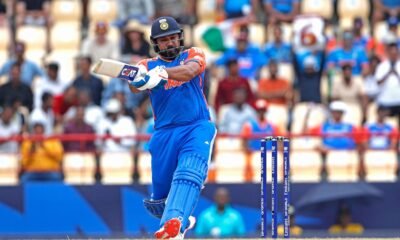Cricket
Recent Match Report – India vs Australia Final 2023/24
[ad_1]
Australia 241 for 4 (Head 137, Labuschagne 58*, Bumrah 2-43) beat India 240 (Rahul 66, Kohli 54, Starc 3-55, Cummins 2-34, Hazlewood 2-60) by six wickets
What might have been for these two teams had Head not held onto a steepling, sprawling take, running backwards into the covers to saw off India’s captain, Rohit Sharma, in his prime? Australia’s eventual target of 241 would have been significantly higher, no doubt, and to judge by the ferocity with which India’s new-ball bowlers clawed at their opponents in the powerplay – with Jaspit Bumrah and Mohammad Shami inevitably to the fore – there would have been all the more opportunities for their chase to have toppled off its tightrope.
Instead, Head held on, and in so doing, he applied a handbrake to a runaway innings that would never be fully released. On Rohit’s watch, India had racked up 10 fours and three sixes in blazing along to 80 for 2 in the first powerplay, the joint-highest phase total ever made batting first in a World Cup final. Once he’d gone, India mustered just four more fours, and 160 more runs, across the next 40 overs. It meant they were unable to post a total big enough to mitigate against the inevitable onset of dew – the primary reason why Pat Cummins had risked letting Rohit and Co. set the agenda in the first place.
And so Australia’s victory came at a canter in the end, with six wickets standing and a huge 42 balls unused – a margin that would have been greater still but for Head’s dismissal to the penultimate ball of the chase. Undeterred, Glenn Maxwell pulled his first ball for two to take his side through to a victory target which – as fate would have it – was the exact total that England and New Zealand had been unable to split by conventional means four years ago.
But that ease at the finish told nothing of the jeopardy that had preceded it. At 47 for 3 after seven overs, with Steven Smith inexplicably failing to review an lbw from Bumrah that was shown to have struck his pad outside off, Australia were in the thick of a do-or-die tussle against two of the most outstanding performers of India’s previously peerless campaign.
David Warner, in his final ODI innings, had scuffed Shami’s first legitimate delivery to Virat Kohli at slip for 7, having fenced his own first ball of the innings (from Bumrah) past the same fielder’s boot for four, and with Mitchell Marsh’s attempt to hit the quicks off their lengths ending in a loose cut through to the keeper, the crowd had found its full voice for the first time in the game.
[ad_2]


















